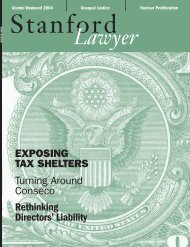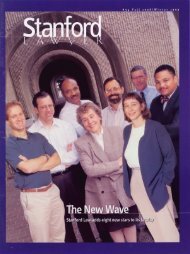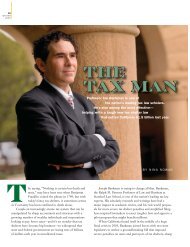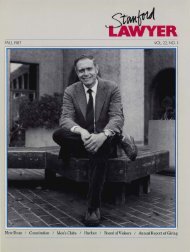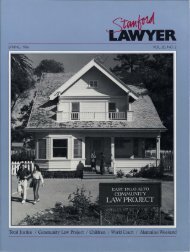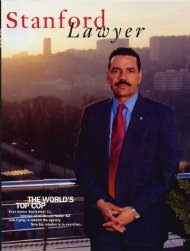FACULTV NOTES (cant.) Professor Gunther was at <strong>Stanford</strong>. In Decem- be the first member ofthe <strong>Stanford</strong> Humanities recently honored in the ber, his article "Pigovian the Corporation to haveCenter. He will spend dedication of the 1982 Taxation with Administra- been a female under-<strong>1983</strong>/84 at the Center edition of the Supreme tive Costs" (coauthored graduate at Yale.exploring the role of nar- Court Review. The in- with Professor Stevenrative in case law. Last scription read: "To Shavell of Harvard Law Professor Michael S.October, Grey presented Gerald Gunther - For School) was published in Wald has been aptheMellon Lecture at the whom the Constitution is the Journal of Public pointed to the Juvenile<strong>University</strong> of Pittsburgh a guide and not a tool." Economics. Justice Commission ofLaw School; an ex- Polinsky participated Santa Clara County. Anpanded version, entitled Professor J. Myron in two interesting events authority on family and"Langdell's Orthodoxy," Jacobstein participated this spring: a colloquium juvenile law, Wald haswill appear soon in the in a panel on law librar- in New Orleans, "Dam- helped draft legislationPittsburgh Law Review. ies for the Dean's Work- ages in Contract Law," dealing with child abuseProfessor Grey recent- shop at the American sponsored by the Law and neglect. The Comlyserved (as an outside Bar Association meeting and Economics Center mission is a citizenmember) on the Anthro- in February. That same of Emory <strong>University</strong>; and body, mandated by stapologyDepartment com- month, he journeyed to a CEPR workshop, "In- tute, which monitors themittee that recom- Costa Rica to attend a centives in Markets and performance of Countymended expulsion of seminar on human rights Organizations," held at agencies dealing with ju-China-researcher Steven research, sponsored by <strong>Stanford</strong>. veniles, reviewsMosher. "Regrettably - the Inter-American Insti- budgets, and providesbecause some evidence tute on Human Rights. Professor Robert Rabin advice and counsel tomight endanger innocent saw the second edition County authorities. Inparties - our report John Kaplan, Jackson of his book Perspectives addition, Professor Waldcould not be published," Eli Reynolds Professor of on Tort Law (Little, has been elected to thehe notes, "nor could the Law, was an honored Brown & Co.) published board of the Nationalgrounds for expulsion be guest on two campuses in February. He is now Committee for the Prerevealed."this winter: <strong>University</strong> of writing a new book, on vention of Child Abuse,Illinois, Champaign- the historical develop- and of the National Ju-Gerald Gunther, William Urbana, where he gave ment of the federal reg- venile Law Center. ThisNelson Cromwell Pro- the Baum Lecture (on ulatory system. Rabin past year, as a Gugfessorof Law, has pre- "Capital Punishment"); served as a panelist in genheim Fellow, he haspared an extensive dis- and Florida State Uni- January for a roundtable been working on a bookcussion paper for the versity, Tallahassee, for on torts, sponsored by on child abuse and ne-<strong>1983</strong> Chief Justice Earl the Mason Ladd Lecture. the American Associa- glect.Warren Conference of Both universities plan to tion of Law Schools. And•the Roscoe Pound Amer- publish the lectures in in February, he preicanTrial <strong>Lawyer</strong>s their respective law sented a paper - "Legi-Foundation. The annual reviews. timacy, Discretion, andConference, held this A book by Kaplan, the Concept of Rights"year in Charlottesville, The Hardest Drug - - at a Yale conferenceVirginia, is attended by Heroin and Public Policy, on the legacy of the Newan invited grou p of par- has just been published Deal. The paper willticipants from the bench, by the <strong>University</strong> of Chi- appear soon in the Yalebar, academia, govern- cago Press. (An article Law Journal.ment, and the media. drawn from the book be-Gunther's paper, "Con- gins on P. 4.) Professor Deborahgressional Power to Cur-Rhode is now a fellow oftail Federal Court Juris- A. Mitchell Polinsky·, the Yale Corporation, thediction: An Opinionated professor of law and governing body of YaleGuide to the Ongoing associate 'professor of <strong>University</strong>. She wasDebate," will be pub- economics, has been elected by alumni/ae tolished (together with the appointed to the steering the seat previously helddiscussion by Confer- committee of the new by Bayless Manningence participants) by the Center for Economic (former dean of <strong>Stanford</strong>Foundation. Policy Research (CEPR) Law School). Rhode will60 <strong>Stanford</strong> <strong>Lawyer</strong> <strong>Fall</strong> <strong>1983</strong>
IITHRIFT INSTITUTIONScontinuedConclusionThis survey of the new financial servicesenvironment and some of itslegal ramifications has been bothbroad and general, as befits an attemptto get a sense of the decadeahead. I have no great confidence insome of the specific conclusions thathave been drawn, but I believe thatthe forces and questions examinedare ones that need to be kept inmind. --In principle, all of the legal problemsthat have been referred to canbe dealt with byappropriate changesin the statutes or regulations. That isnot to say that all of those changeswill in fact be made, or in a timelyfashion, because there are opposinginterest groups, and the politicalsystem has considerable inertia. Butlegal problems are not necessarilyintractable, and in fact the law offinancial regulation has been changingat a fairly rapid pace in the pastdecade.The economic and technologicalforces we have been discussing, onthe other hand, cannot be abolishedby an act of Congress, though thereare those who try. In the end, suchforces must be adapted to, in oneway or another. While the basicfunctions of financial intermediationwill continue to be performed, nothingguarantees the survival of a particulartype of financial intermediary.The public does not much careabout "level playing fields" or thelabel of the institution providingfinancial services; it cares muchmore about the cost, quality, andconvenience of the services.I am sure there are more responsesto the problems I have beendiscussing than the ones I have identified;our financial system is remarkablyadaptable and inventive.But I am also sure thatsurvival in theInew environment requires addressingthose problems and devising aplan to cope with them that is tailoredto the circumstances of a giveninstitution. I hope that the law willnot make that more difficult than itneed be, butmyadvice is: Don't bankon it..* * *This article-slightly revised from apaper presented by Professor Scott ata conference on December 9, 1982-isprinted with the permission ofFederalHome Loan Bank of San Francisco,sponsor ofthe conference. The originalpaper appears in Proceedings of theEighth Annual Conference: StrategicPlanning for Economic andTechnological Change in the FinancialServices Industry, published thisspring by Federal Home Loan Bank ofSan Francisco. Scott discussed thebackground and early implications ofthe 1980 bankingderegulation act in aprevious <strong>Stanford</strong> <strong>Lawyer</strong> article(<strong>Fall</strong>/Winter 1981).Professor Scott was recently named tothe new Ralph M Parsons Professorshipin Law and Business (see articlein School News section).HEROIN continuedof the heroin he receives from themaintenance system even while remainingaddicted.Law Enforcement andIllegal SalesUnfortunately, we cannot rely onthe threat of detection to prevent theaddict from selling some of hisheroin supply. Though the clinic canuse urine tests to monitor whetherhe uses methadone or street heroincut with various substances, it cannotdetermine whether he has usedall the heroin that has been prescribed-for him. As a result, urin-alysis would be a deterrent only tothe addict's selling all of his supply.And urinalysis is not foolproof, evenfor this purpose.Nor could the police do much. Theaddicts in heroin maintenance wouldbe far too numerous to watch; theywould be legally in possession oftheir heroin; and could easily maketheir sales in private.In fact, heroin trafficking throughdiversion from a prescriptionmaintenance system would be muchmore difficult for the police to containthan is our present illegal heroindistribution system. Often law enforcementis best able to disruptheroin distribution by intervening atthe higher end of the chain. This isquite difficult, but if the police domanage to seize a large shipment ofheroin, put a large ring out ofbusiness, or disrupt cultivation in aforeign country, there may be asizable- if temporary- contractionin the heroin supply.By contrast, where the addict sellsthe heroin prescribed for him, themaintenance system itself takes theplace of the illegal manufacturer, importer,large-scale wholesaler, andsmall-scale wholesaler. The hugenumber of extremely short supplychains- each consisting of an addictin maintenance and his customerswouldmake the illegal market virtuallyinvulnerable to law enforcement.The prescription heroin maintenancesystem may create a whollynew and very large class of regularsellers who will make heroin moreaccessible as well as cheaper. Evenamong the relatively noncriminalEnglish addicts, one study showedthat 11 percent regularly sold part oftheir heroin supply. In the UnitedStates, one would expect the figureto be far higher.We must be concerned with thepurchasers, as well as the sellers, ofprescribed heroin. Many of the customersfor illegally sold heroinwould be nonaddicts. This is the casetoday and there is no reason to think<strong>Fall</strong> <strong>1983</strong> <strong>Stanford</strong> LaWyer 61
- Page 1 and 2:
RFAll 1983VOL. 18, NO.1Heroin Optio
- Page 3 and 4:
jah(e,oYCONTENTSSTANFORD lAWYEREdit
- Page 5 and 6:
Business Law vs. Public Interest La
- Page 7 and 8:
By John Kaplanjockson Eli ReynoldsP
- Page 9 and 10:
maintenance almost entirely up toth
- Page 11: smaller percentage of British addic
- Page 14 and 15: that, because of regulation, cannot
- Page 16 and 17: of a whole variety of new mortgagei
- Page 18 and 19: ConversationsWith Five AlumniBy Mic
- Page 20 and 21: y landlords and tenants about rents
- Page 22 and 23: when I was studying law and she was
- Page 24 and 25: ~o(1)AtISSUE *Union 'Rights' in the
- Page 26 and 27: AtISSUECongressional Responses toSu
- Page 28 and 29: AtISSUEPrison Labor:TimeTo Take Ano
- Page 30 and 31: Graduates and friends of theSchool
- Page 32 and 33: ~o~ 4'-VVcYi~STATE OF THE SCHOOLJoh
- Page 34 and 35: ~o~ Cff-VIMtu'0r-STATE OF THE SCHOO
- Page 36 and 37: ~o~ 4-(/141~STATE OF THE SCHOOL con
- Page 38 and 39: ~o~4VJ41~SUCCESSFUL LAWYERING:IMPLI
- Page 40 and 41: ~o~of-VJM~SUCCESSFUL LAWYERING cont
- Page 42 and 43: @.oarcA 4l!141~THE CONSTITUTION, RA
- Page 44 and 45: @o~4t1J41~.LAW AND BUSINESS PROGRAM
- Page 46 and 47: @otwrA 4vJ41~ .SUMMARY AND ADVISORY
- Page 48 and 49: David L. Engel(Harvard, JD '73)Bost
- Page 50 and 51: New Faculty (cont.)Michigan Law Sch
- Page 52 and 53: GILSON (cant.)Gilson is currently p
- Page 54 and 55: BabcockAwarded anHonorary LL.D.by S
- Page 56 and 57: CAREER 'ALTERNATIVES' (cant.)2. A s
- Page 58 and 59: Hurlbut WinnerTalks AboutTeachingPr
- Page 60 and 61: Schod;NI Grads Scatter toCities All
- Page 64 and 65: it will be less so if we adopt a he
- Page 66 and 67: than on its edges, thus increasing
- Page 68 and 69: Heroin maintenance is, in manyways,
- Page 70 and 71: c~OTESII1912-25Hon. David Lee Rosen
- Page 72 and 73: c~NOTESthe firm advises, that "Donn
- Page 74 and 75: c~NOTESand had been prominent in a
- Page 76 and 77: spring Dean Ely traveledLEast, wher
- Page 78 and 79: 5Stanford LaWlers:This Page IsYours
- Page 80 and 81: October 11Washington, DC LawSociety
- Page 82 and 83: COMPARATIVE CONTRIBUTIONS TOTHE LAW
- Page 84 and 85: A MESSAGE FROM THELAW FUND PRESIDEN
- Page 86 and 87: CLASSAGENTSLong BeachSterling S. Cl
- Page 88 and 89: Warren Christopher'49 Penny Howe Ga
- Page 90 and 91: Frank L. Mallory '47Richard C. Mall
- Page 92 and 93: Ronald G. Trayner '67Anthony J. Tre
- Page 94 and 95: Walter A. Johnson, A.B. '29 Maxine
- Page 96 and 97: DONORS TO THE LAW FUND• Hon. Murr
- Page 98 and 99: CLASS OF 1948R. Winfield AchorHon.
- Page 100 and 101: • Thomas R. MitchellR. Chandler M
- Page 102 and 103: Paul E. Kreutz• Prof. Richard B.
- Page 104 and 105: Gabriel M. GesmerMichael GilfixCorn
- Page 106 and 107: HIGHEST LEVELSOF PARTICIPATIONLARGE
- Page 108 and 109: FACULTY, FORMERFACULTY &STAFFBarbar
- Page 110 and 111: REUNION GIVINGWhile class reunions
- Page 112 and 113:
DONORS TO SPECIALPROGRAMS AND FUNDS
- Page 114 and 115:
Class of 1954 Reunion Student Finan
- Page 116 and 117:
In Memory of:Clifton C. Cottrell '2
- Page 118 and 119:
Clyde E. Tritt'49William W. VaughnS
- Page 120:
BEQUESTS AND DEFERRED GIVINGBequest





